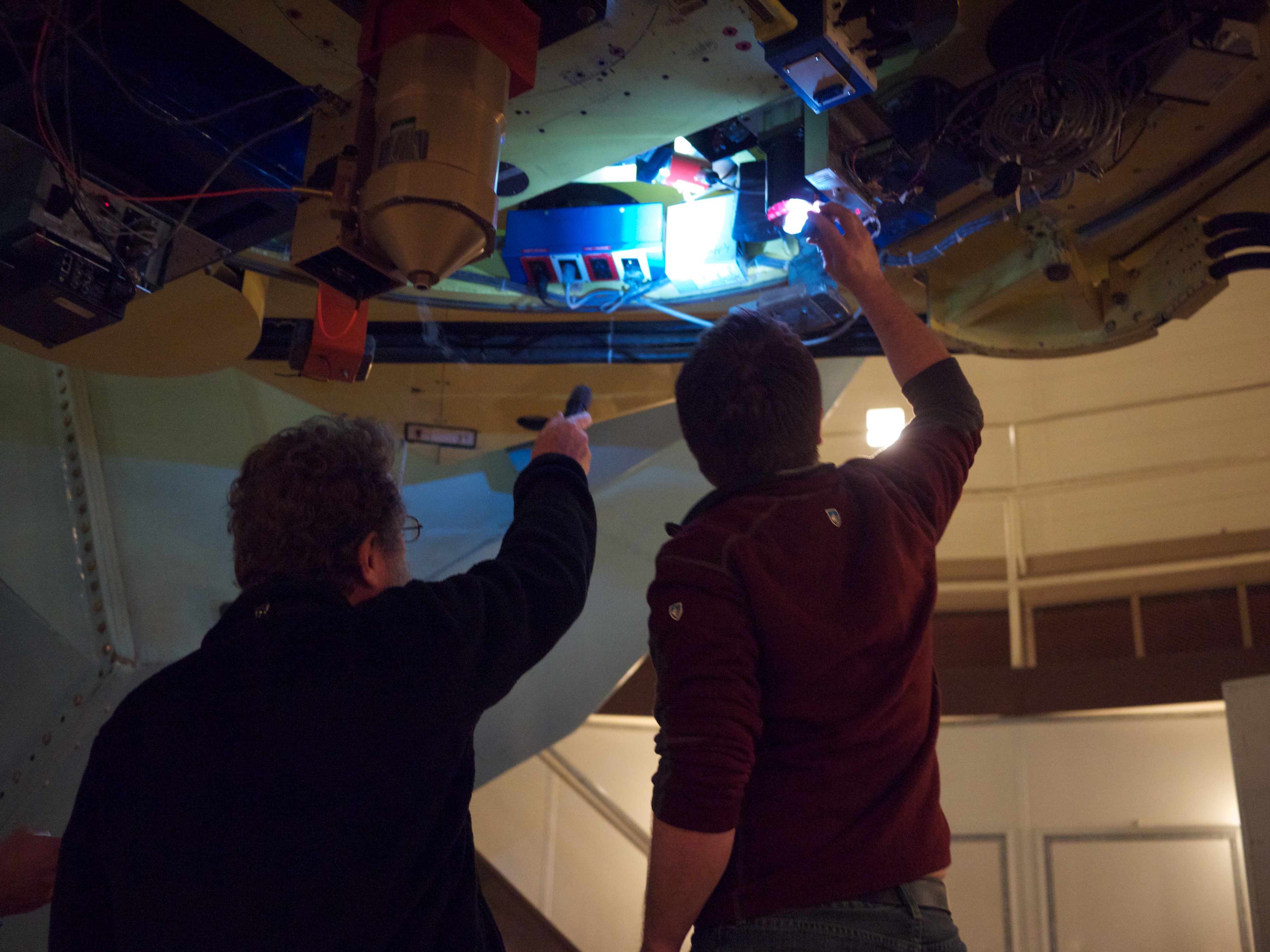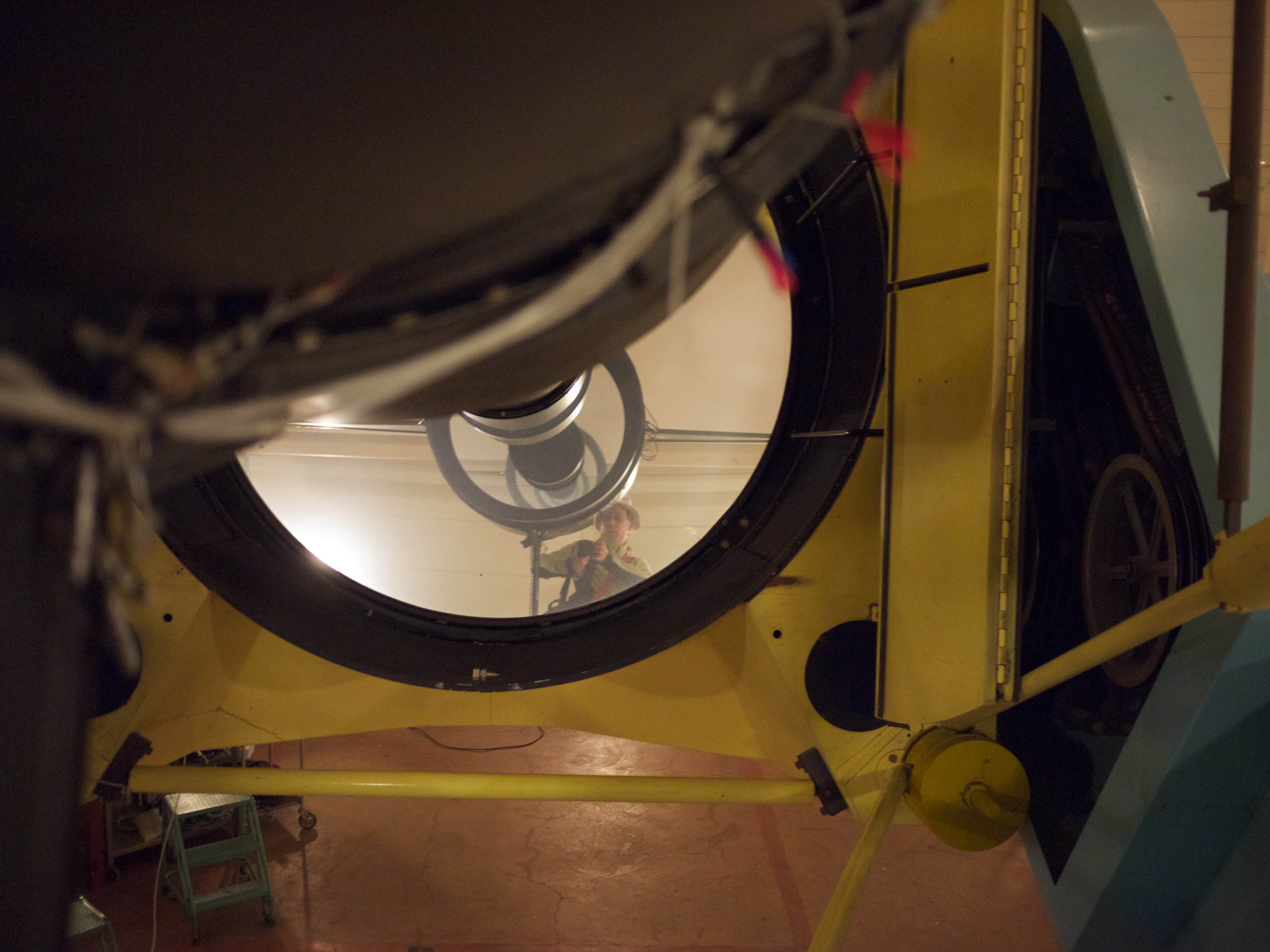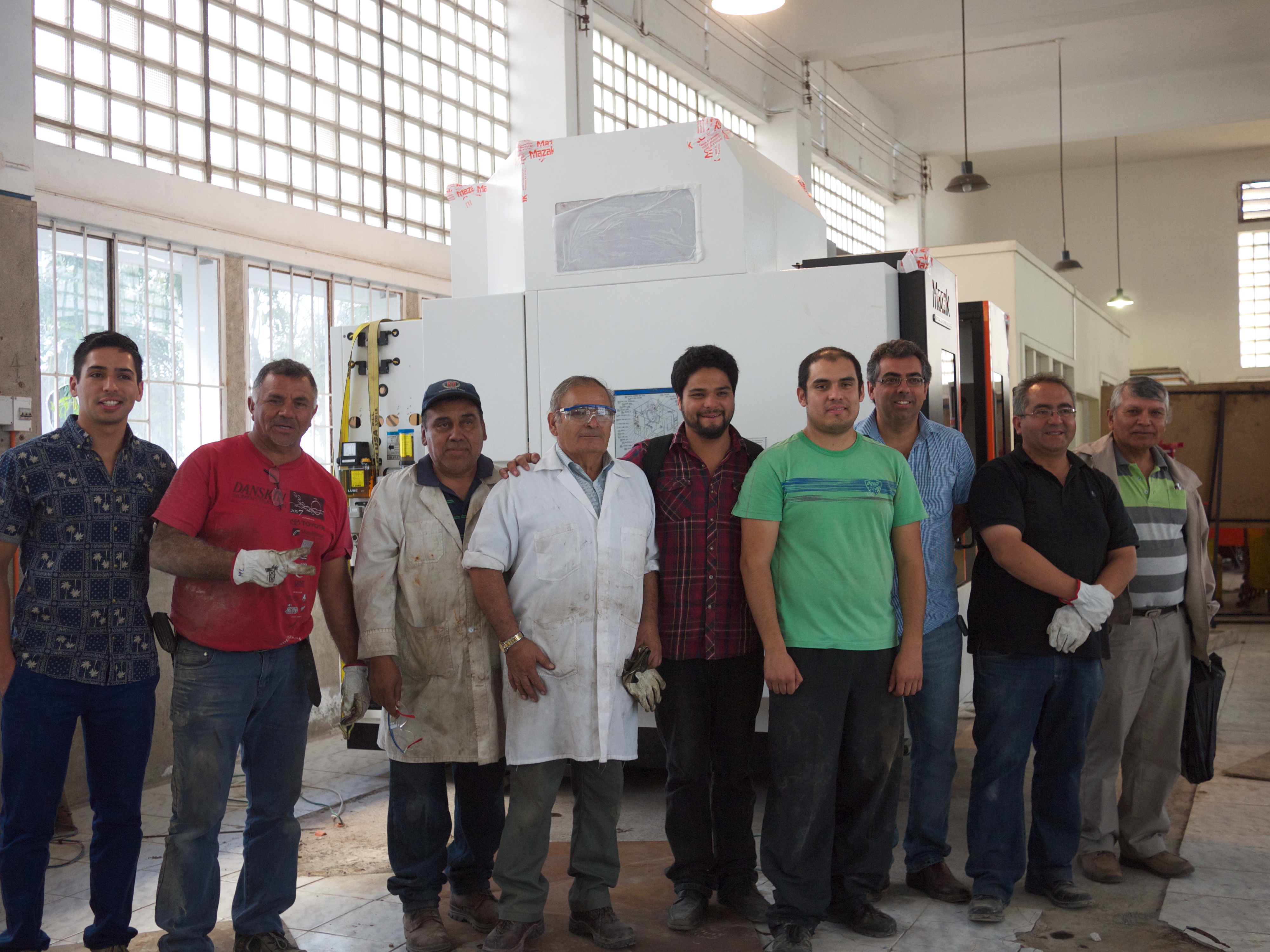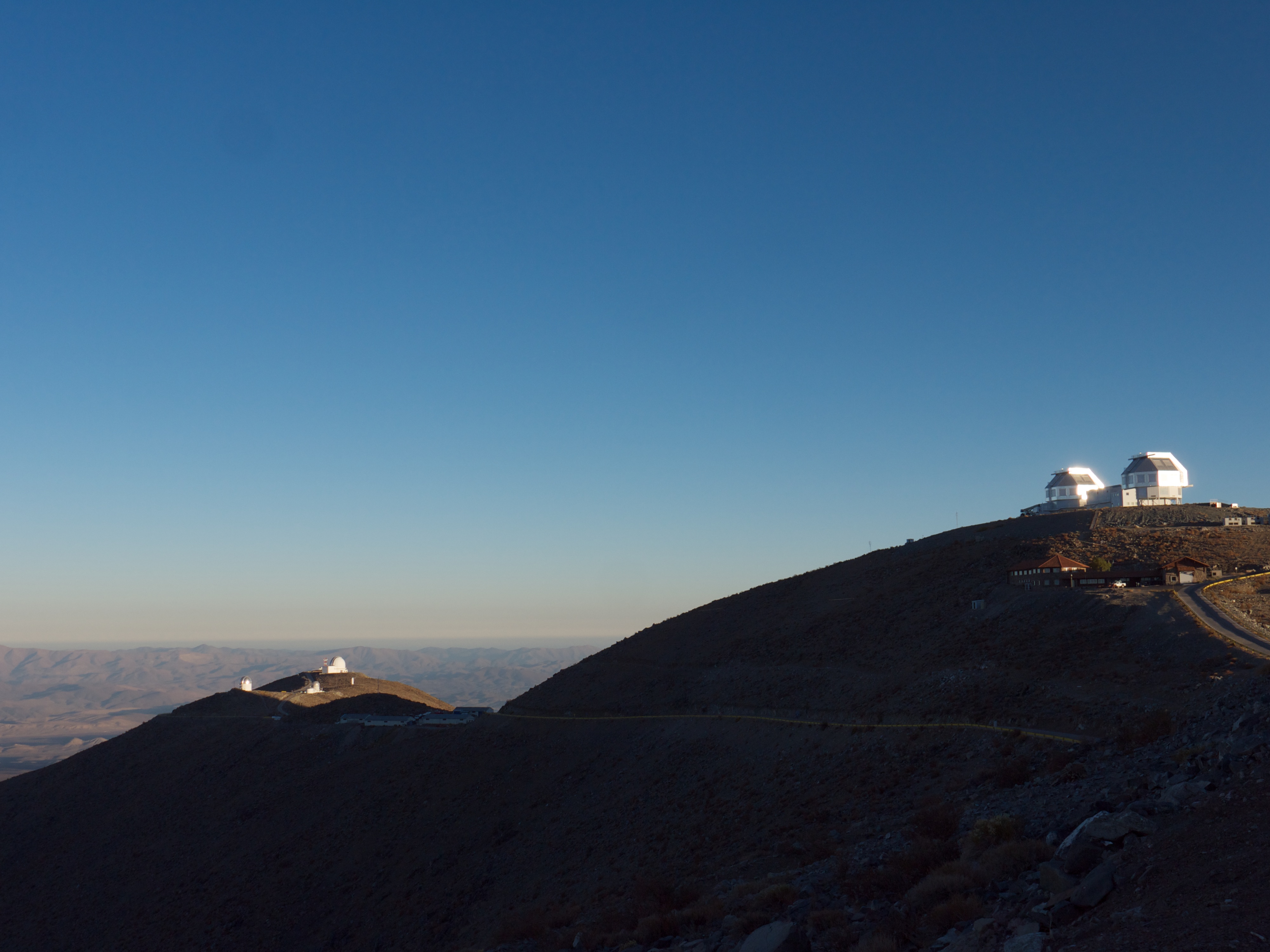
The du Pont 2.5m telescope on the middle-left, and the pair of Magellan 6.5m telescopes on the right.
El telescopio de 2.5m du Pont al centro hacia la izquierda y los dos telescopios de 6,5m, Magallanes, a la derecha.
A half-dozen SDSS scientists and engineers traveled to Las Campanas Observatory, Chile at the beginning of March to continue work on characterizing the 2.5m du Pont telescope performance in preparation for the first APOGEE-South hardware tests in August. This report is from the SDSS Operations Software Manager John Parejko, who was part of the run (and ended up involved in some hardware tests, against his better judgement!). Translated into Spanish by Verónica Motta, Full Professor of Astronomy at Valparaiso University.
Las Campanas Observatory currently hosts three “large” telescopes (greater than 2 meters diameter), and a number of 1 meter diameter and smaller telescopes. The 2.5m du Pont telescope (in use since 1977) is a much older telescope than the 2.5m Sloan telescope at APO (in use since 1999), but it is at an excellent site, its optics are still very good–I heard them referred to as “superb” on several occasions–and it has a large field of view. With the assistance of the telescope’s owners–the Carnegie Institution of Washington–SDSS plans to help design improvements to the telescope drive systems so that we can run an APOGEE-South survey and fully sample the Milky Way’s bulge.
Una media docena de científicos e ingenieros del SDSS viajaron al Observatorio Las Campanas (Chile) a principios de marzo para continuar el trabajo de caracterización del rendimiento del telescopio de 2.5m du Pont en preparación para la primera prueba de hardware de APOGEE-Sur que se realizara en agosto. Este informe proviene del Director de Operaciones de Software del SDSS, John Parejko, que participó en la ejecución (y que terminó involucrado en algunas pruebas de hardware, en contra de su mejor juicio ! ). Traducción de Verónica Motta, profesor de astronomía en la Universidad de Valparaíso.
El Observatorio Las Campanas actualmente alberga tres “grandes” telescopios (mayores de 2m de diámetro), y varios más pequeños de hasta 1m de diámetro. El telescopio de 2.5m du Pont (en uso desde 1977) es más antiguo que el telescopio de 2.5m Sloan en el Observatorio Apache Point (APO, en uso desde 1999), pero está en un lugar excelente, su óptica es todavía muy buena -he oído referirse a ella como “excelente” en varias ocasiones- y tiene un gran campo de visión. Con la ayuda de los propietarios del telescopio -la Institución Carnegie de Washington- el SDSS planea ayudar a mejorar el diseño de los sistemas de accionamiento del telescopio de manera que podemos realizar el relevamiento APOGEE-Sur y muestrear completamente el bulbo de la Vía Láctea.
In order to determine what improvements the telescope requires, we have to make precise measurements of how different parts of the telescope move. From previous work, we found that the Right Ascension and Declination motors (equivalent to latitude and longitude projected onto the sky) probably don’t need much work. This trip, we measured the motion of the rotator and focus systems. Carnegie is in the process of completing their own upgrades to the telescope, and our measurements will help guide these changes.
Con el fin de determinar qué mejoras necesita el telescopio tenemos que hacer mediciones precisas de cómo se mueven las diferentes partes del telescopio. A partir de trabajos anteriores, encontramos que los motores de la Ascensión Recta y de la Declinación (equivalentes a la latitud y a la longitud proyectada sobre el cielo) probablemente no necesitan mucho trabajo. En este viaje medimos el movimiento del rotador y del sostema de enfoque. Carnegie se encuentra en el proceso de terminar sus propias mejoras al telescopio y nuestras medidas servirán de guía para estos cambios.
To focus a telescope like this one, you move the secondary mirror. Even tiny changes in the position or tilt of the secondary can result in incorrect or uneven focus when you need a large field of view, as APOGEE will. As the du Pont is an older telescope, the system that moves the secondary mirror may not be as stable as APOGEE requires.
We first checked whether the mirror moved the exact amount each time it was commanded. We’ve found that the mirror motors need to be more repeatable: moving 500 “up” and then 500 “down” should return to exactly the same place, but it doesn’t. The Carnegie engineers are now working to improve the motors and control systems to fix this.
Para enfocar un telescopio como éste se mueve el espejo secundario. Incluso pequeños cambios en la posición o en la inclinación del secundario pueden resultar en un foco incorrecto o irregular en un gran campo de visión como el que utilizará APOGEE. Como el telescopio du Pont es viejo, el sistema que mueve el espejo secundario puede no ser tan estable como requiere APOGEE.
Primero revisamos si el espejo se movió la cantidad correcta cada vez que se le ordenó. Hemos encontrado que los motores del espejo tienen que ser más confiables: moverse 500 hacia “arriba” y después 500 hacia “abajo” debería regresarlo exactamente al mismo lugar, pero no es así. Los ingenieros de Carnegie están trabajando para mejorar la motores y los sistemas de control para solucionar este problema.
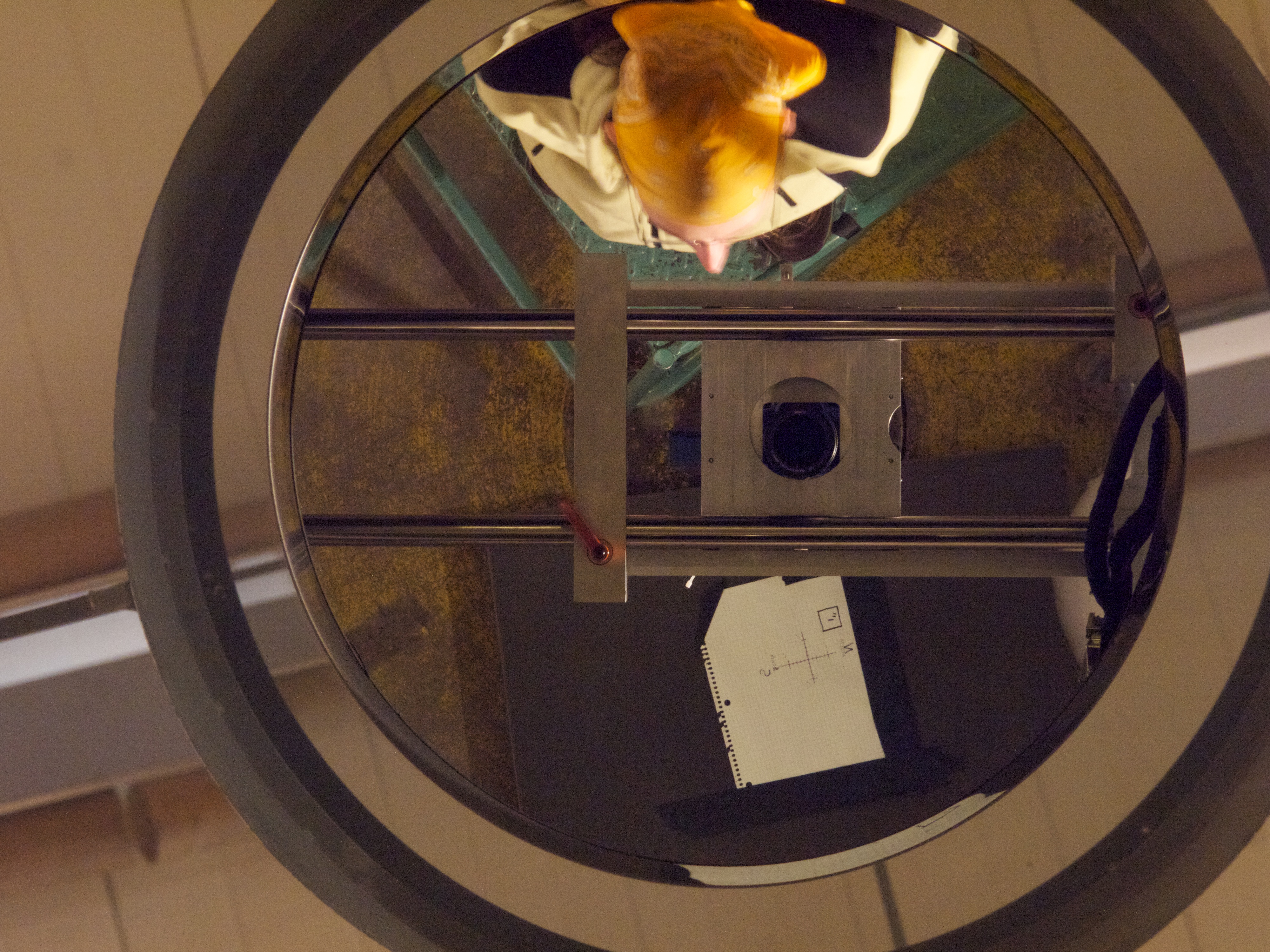
Author self portrait in the du Pont secondary, with my camera and our measuring target visible.
Autorretrato del autor en el secundario del du Pont, con mi cámara y nuestro objeto de medición visible.
To measure any shift or tilt in the secondary, we used a rather interesting system: a typical camera (the Panasonic G2 that I travel with for touristy photos; it took all the pictures shown in this post) with a long telephoto lens mounted on a moveable rail, taking pictures of the image in the secondary mirror of a “target” on the floor. We then took pictures with the camera and measured whether the target moved around: if it doesn’t move from image to image, we know the secondary is very stable against tilts and shifts during movement. We’re still analyzing the results of these tests, and will use them to detail what changes need to be made.
Para medir cualquier desplazamiento o inclinación en el secundario usamos un método interesante: una cámara típica (la Panasonic G2 con la que viajo para tomar fotos turísticas; la que tomó todas las imágenes que se muestran aquí) con un teleobjetivo largo montado en un carril móvil, toma fotos de la imagen en el espejo secundario de un “objetivo” en el suelo. Entonces tomamos fotos con la cámara y medimos si el objetivo se movió: si no se mueve de imagen a imagen, sabemos que el secundario es muy estable ante las inclinaciones y los cambios durante el movimiento. Todavía estamos analizando los resultados de estas pruebas y las usaremos para detallar los cambios deben hacerse.
—
Además de mi trabajo de ingeniería en el telescopio du Pont, tuve tiempo durante la noche para fotografiar el cielo austral. Este fue mi primer viaje al hemisferio sur y me aseguré de levantarme temprano al menos una mañana para ver las Nubes Mayor y Menor de Magallanes y toda la gloria de la Vía Láctea austral. Tuve que levantarme temprano para evitar la Luna casi llena, que disminuye la visibilidad. Sin duda tienen cielos espectaculares ahí abajo.
In addition to my engineering work on the du Pont telescope, I was able to take some time at night to photograph the southern sky. This was my first trip to the southern hemisphere, and I made sure to get up early at least one morning to see the Large and Small Magellanic Clouds and the full glory of the southern Milky Way. I had to get up early in order to avoid the nearly-full moon, which otherwise much diminished the view. They’ve certainly got some spectacular skies down there!
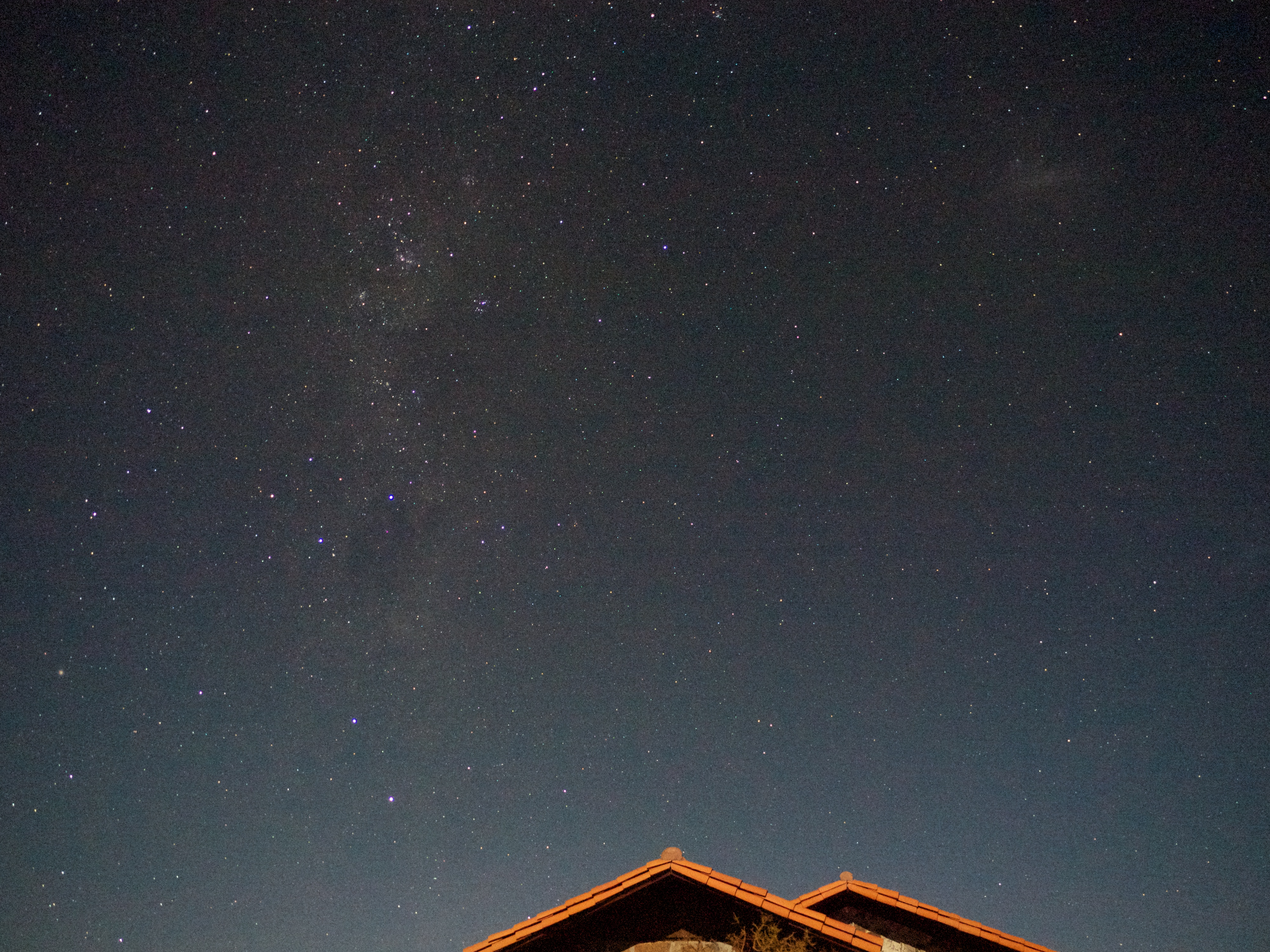
La Vía Láctea y las Nubes Mayor y Menor de Magallanes Nube en el hemisferio austral, sobre el edificio principal del LCO.
The southern hemisphere Milky Way and Large Magellanic Cloud, over the main LCO building.
Pasé mis últimos días de este viaje en la ciudad de La Serena, reunido con la gente de la Universidad de La Serena (ULS) y reuniendo los resultados de las pruebas. Durante este tiempo, pude ver como la escuela de ingeniería ULS maniobró la nueva máquina, marca Mazak CNC, con cuidado hasta su lugar en el taller de mecánica. Las instituciones chilenas han utilizado la colaboración SDSS/Chile para reforzar su infraestructura a través de subvenciones y varios acuerdos. En este caso, fueron capaces de comprar el modelo más avanzado de fresadora computarizada que planean utilizar para construir piezas para APOGEE-Sur.Tengo ganas de ver que pueden construir con ella!
I spent my last days of this trip in the city of La Serena, meeting with people at the University de La Serena (ULS) and collating results from the tests. During this time, I was on hand to watch as the ULS engineering school had a brand new Mazak CNC machine carefully maneuvered into place in their machine shop. Chilean institutions have used the SDSS/Chile collaboration to bolster their on-site infrastructure via grants and various agreements. In this case they were able to purchase a state-of-the- art computerized milling machine that they plan to use to construct parts for APOGEE-South. It will also provide engineering student training and experience, and allow the university to construct other cutting edge scientific equipment in the future.
I’m looking forward to see what they can build with it!
